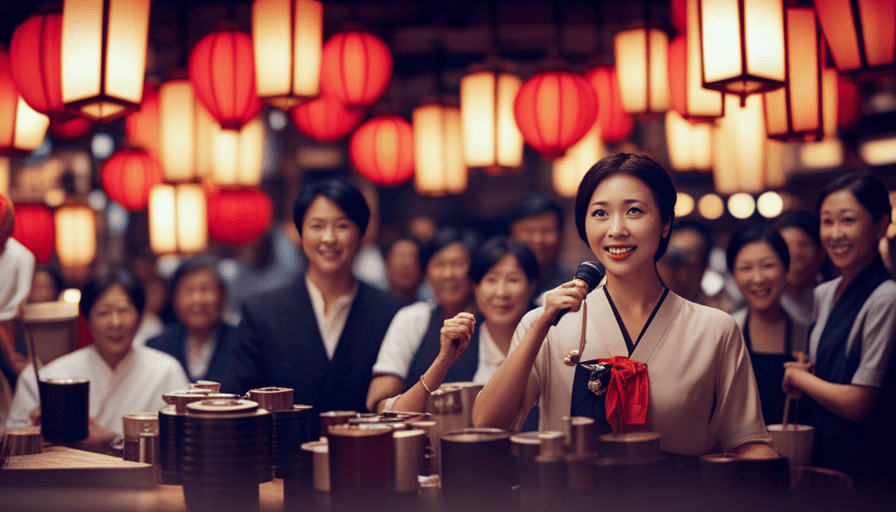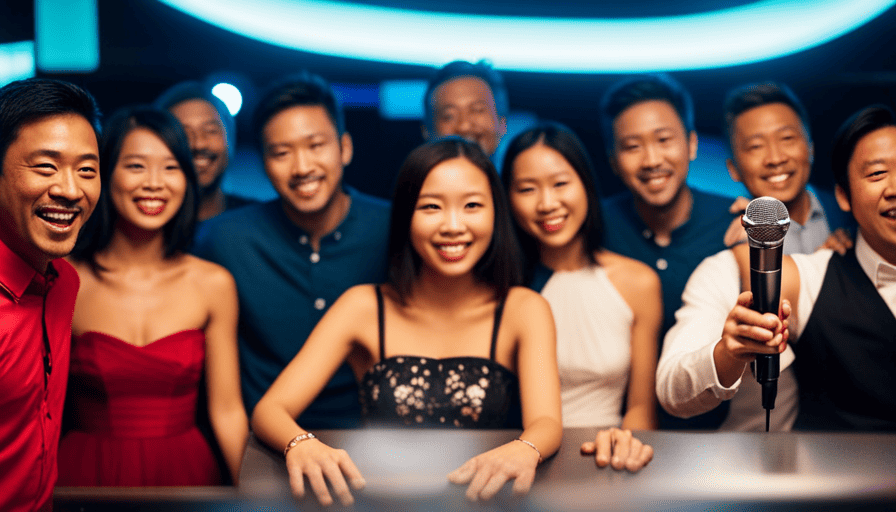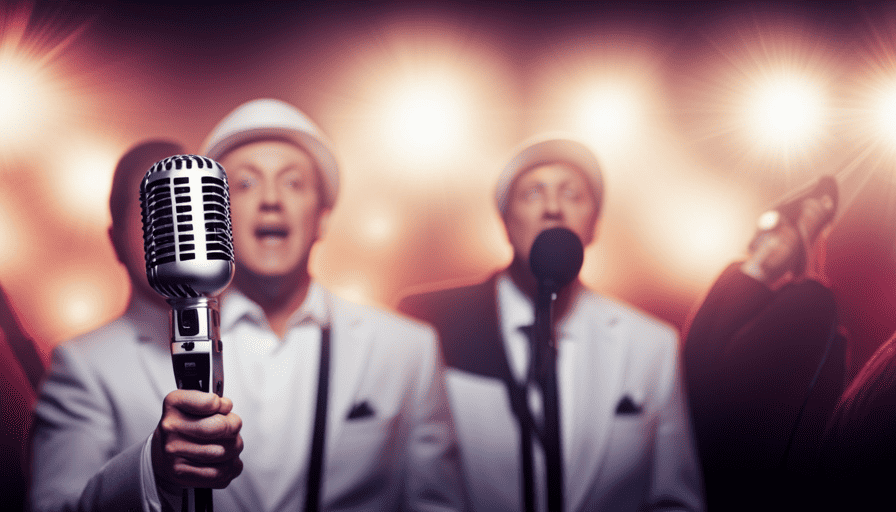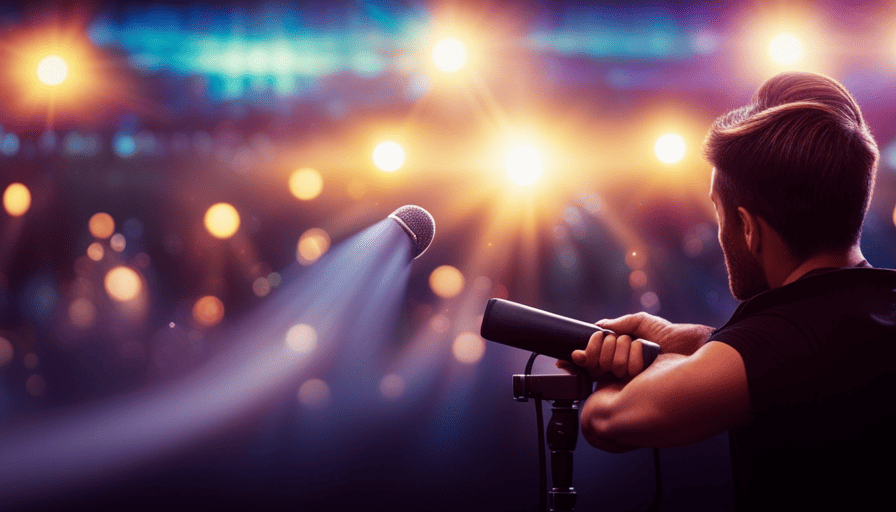Did you know that the term ‘karaoke’ is acknowledged in over 100 countries worldwide? This popular form of entertainment has certainly become internationally famous. But have you ever thought about the origins of the term ‘karaoke’?
In this article, we will delve into the origins of this fascinating term and uncover its rich history.
Karaoke, as we know it today, originated in Japan in the early 1970s. It was invented by a musician named Daisuke Inoue who wanted to provide backing tracks for his customers to sing along to during performances.
The word ‘karaoke’ itself is a combination of two Japanese words: ‘kara,’ meaning empty, and ‘oke,’ short for orchestra. Together, they create the concept of singing along to pre-recorded music without any vocal accompaniment.
Since its invention, karaoke quickly gained popularity in Japan and eventually made its way across borders into Western countries. Today, you can find karaoke machines at bars, parties, and even in the comfort of your own home.
This article will explore how karaoke has evolved over time and examine its impact on pop culture. So get ready to dive into the fascinating world of karaoke and discover where this beloved term truly comes from!
Key Takeaways
- The word ‘karaoke’ comes from the combination of ‘kara’ meaning empty and ‘oke’ meaning orchestra in Japanese.
- Karaoke originated in Japan in the early 1970s by musician Daisuke Inoue.
- Karaoke machines were initially cassette players connected to amplifiers and speakers.
- Karaoke quickly gained popularity in Japan and spread to Western countries.
Music in Japan: A Brief Overview
So, if you’re interested in music in Japan, let’s dive into a brief overview that will give you a deeper understanding of the cultural significance and impact it has had on the world.
Music education in Japan is highly valued and plays an integral role in the country’s educational system. Students receive comprehensive training in both Western classical music and traditional Japanese instruments. This emphasis on music education has helped to cultivate a rich musical heritage that encompasses a wide array of genres, from ancient court music like gagaku to modern pop and rock.
Traditional Japanese instruments hold a special place in Japanese music culture. Instruments such as the shamisen, koto, and shakuhachi have been used for centuries to create beautiful melodies that reflect the essence of Japanese aesthetics. Learning these instruments requires dedication and discipline, as they have unique playing techniques and tunings.
The influence of traditional Japanese music can be seen even in contemporary popular songs, where artists often incorporate elements of traditional instrumentation or employ melodic patterns inspired by traditional scales.
Now that we’ve explored the foundations of music in Japan, let’s move onto discussing the invention of karaoke without missing a beat.
The Invention of Karaoke
To understand the invention of karaoke, imagine yourself in a bustling Japanese bar in the 1970s, where friends gathered to sing along to popular songs without needing a live band. The inventor of karaoke is Daisuke Inoue, a musician and entrepreneur from Kobe, Japan. Inoue came up with the idea when a customer asked him to provide recorded music for her to sing along to during her business trip. He realized that there was a market for this kind of entertainment and developed an early version of the karaoke machine.
These early karaoke machines were quite different from what we know today. They consisted of a cassette player connected to an amplifier and speakers. Users would choose their favorite song from a selection of tapes and sing along using a microphone. This simple setup allowed people to enjoy singing without having any musical talent or needing a live band.
The popularity of karaoke quickly spread throughout Japan and eventually made its way around the world. But how did it come to be called ‘karaoke’? Stay tuned for the next section where we dive into the meaning behind this intriguing word.
The Meaning of the Word "Karaoke"
Unraveling the mystery behind this captivating term, ‘karaoke’, reveals a world of cultural significance and linguistic intrigue. The origin of karaoke can be traced back to Japan in the 1970s. The word itself is derived from two Japanese words: ‘kara’ meaning ’empty’ and ‘oke’ which is short for ‘okesutora’, meaning ‘orchestra’. This combination reflects the essence of karaoke, where individuals sing along to pre-recorded music tracks without any vocal accompaniment.
In different cultures around the world, karaoke has taken on various forms and names. In Korea, it is called noraebang, which translates to ‘singing room’. In China, it is known as KTV or karaoke television. These variations highlight the global appeal of this form of entertainment.
Karaoke’s rise in popularity in Japan can be attributed to its ability to bring people together and provide a platform for self-expression. It quickly became a popular pastime in bars and clubs, allowing individuals to showcase their singing talents or simply have fun with friends.
Transitioning into the subsequent section about ‘karaoke’s rise in popularity in Japan’, we delve deeper into its impact on culture and society as well as its influence on music industries worldwide.
Karaoke’s Rise in Popularity in Japan
Little did anyone expect, but karaoke skyrocketed in popularity in Japan, becoming a cultural phenomenon that brought people together and showcased hidden talents. Karaoke’s impact on social gatherings was profound as it provided a unique form of entertainment where anyone could participate.
People would gather in karaoke bars or private rooms, singing their hearts out and cheering for each other’s performances. It became a way for friends and colleagues to bond, letting loose and enjoying themselves in a relaxed setting.
In addition to its impact on social gatherings, karaoke played a significant role in the Japanese entertainment industry. It created opportunities for aspiring singers to showcase their talent and potentially launch their careers. Many successful artists today started their journey by performing at karaoke venues or participating in karaoke competitions.
Karaoke’s rise in popularity also led to the introduction of specialized equipment and software tailored for this form of entertainment. Manufacturers began producing home karaoke systems, allowing people to enjoy singing without leaving the comfort of their own homes.
As karaoke gained traction worldwide, its introduction to the western world marked another milestone in its history. Without taking a step back, let’s explore how this cultural phenomenon transcended borders and took the world by storm.
Karaoke’s Introduction to the Western World
Karaoke’s arrival in the western world brought a whole new level of musical fun and entertainment to people’s lives. The introduction of karaoke in America marked a turning point in the music industry. With its origins in Japan, this interactive form of entertainment quickly gained popularity among Americans during the late 1970s and early 1980s.
The impact of karaoke on the music industry was significant. It provided a platform for aspiring singers to showcase their talents and gain exposure. Karaoke bars became hotspots for both amateur and professional musicians, creating a thriving community where artists could connect with their audience on a more personal level.
Moreover, karaoke also had an influence on the way music was produced. Record labels saw an opportunity to tap into this growing trend by releasing karaoke versions of popular songs, allowing fans to sing along with their favorite tunes at home or parties. This led to an increase in sales and revenue for the music industry as consumers eagerly embraced this new form of entertainment.
As we delve further into the topic of karaoke’s impact, it becomes evident that its introduction to the western world sparked a revolution that transformed how we engage with music. Next, let’s explore how advancements in technology revolutionized the way we experience karaoke: enter the karaoke machine revolution…
The Karaoke Machine Revolution
Step into a world where technology takes center stage, and you become the star of your own show with the karaoke machine revolution. The introduction of karaoke machines in the 1980s transformed the way people experienced music and entertainment. Karaoke machine sales skyrocketed as individuals embraced the idea of singing along to their favorite songs in the comfort of their own homes or at parties. This new form of interactive entertainment quickly gained popularity and had a significant impact on the live music industry.
To give you an idea of the widespread appeal, here’s a table showcasing some interesting statistics:
| Year | Total Karaoke Machine Sales (in millions) | Impact on Live Music Industry |
|---|---|---|
| 1980 | 1 | Minimal |
| 1990 | 10 | Noticeable |
| 2000 | 30 | Significant |
| 2010 | 50 | Dramatic |
As you can see, karaoke machine sales steadily increased over time, indicating its growing popularity among consumers. The rise of home karaoke systems allowed people to have fun singing without relying on professional musicians or venues. This shift undoubtedly affected live music establishments as they faced competition from this new form of entertainment.
Transitioning into the subsequent section about ‘karaoke today: from bars to home systems,’ it is fascinating to explore how this trend has evolved and how karaoke continues to be enjoyed by people worldwide.
Karaoke Today: From Bars to Home Systems
Now that we’ve explored the karaoke machine revolution, let’s take a closer look at karaoke today in the digital age.
Karaoke has come a long way since its inception and has now become an integral part of our social lives. With the advent of technology, karaoke has transitioned from being solely available in bars to being accessible through home systems.
In the digital age, karaoke has become more convenient and interactive than ever before. Home systems allow you to sing along to your favorite songs without leaving the comfort of your own living room. Whether it’s a dedicated karaoke machine or just an app on your smartphone, these systems provide endless entertainment for individuals and groups alike.
Karaoke also plays a significant role in social bonding. It brings people together, allowing friends and family to have fun and create lasting memories through music. Singing alongside others fosters a sense of camaraderie and connection, breaking down barriers and inhibitions.
As we delve into the global influence and adaptation of karaoke, we will see how this cultural phenomenon continues to transcend boundaries and captivate audiences worldwide.
Global Influence and Adaptation of Karaoke
In today’s digital age, karaoke has become a global sensation, with over 100 million karaoke enthusiasts worldwide. Its global impact is evident as it has been embraced by cultures spanning the globe.
Karaoke has not only spread to different countries but also adapted to fit the cultural preferences of each region. Karaoke’s cultural adaptation can be seen in its diverse song selections. While English songs dominate in Western countries, Asian nations have their own vast collection of popular songs. In Japan, for example, karaoke machines offer an extensive catalog of J-pop and anime theme songs. Similarly, in South Korea, K-pop hits are widely available for karaoke enthusiasts to sing along to.
Furthermore, karaoke has influenced various aspects of pop culture around the world. It has become a staple entertainment option at parties and gatherings and even spawned reality TV shows dedicated solely to karaoke competitions. Additionally, many artists have gained recognition through their performances on karaoke platforms like YouTube.
As we dive into the next section about ‘karaoke in pop culture,’ let’s explore how this musical phenomenon has shaped our favorite songs and artists without missing a beat.
Karaoke in Pop Culture
Get ready to witness how karaoke has left an everlasting impact on our favorite songs and artists, shaping them into the icons we know and love today. Karaoke has not only become a popular activity for everyday people, but it has also made its mark on pop culture in various ways.
One prominent avenue where karaoke has found its place is in films. From heartwarming moments where characters bond over singing their hearts out to hilarious scenes that bring laughter and joy, karaoke has become a recurring theme in many movies. It adds an element of relatability and authenticity, allowing audiences to connect with the characters on a deeper level.
Karaoke has also made its way into advertising campaigns, becoming a powerful tool for brands to engage with consumers. By incorporating well-known songs into their commercials and encouraging viewers to sing along, companies create a memorable experience that builds brand recognition and leaves a lasting impression. This clever use of karaoke not only entertains but also establishes an emotional connection between the audience and the brand.
As we explore the future of karaoke: technological advancements and trends, we will delve into how technology continues to shape this beloved pastime while propelling it forward into new realms of creativity and convenience.
The Future of Karaoke: Technological Advancements and Trends
Imagine yourself stepping into a karaoke bar of the future, where mind-reading technology seamlessly selects the perfect song for you based on your thoughts and emotions. The future of karaoke isn’t just about singing along to pre-recorded tracks; it’s about harnessing cutting-edge technologies to create an immersive and personalized experience.
One exciting development in the world of karaoke is virtual reality (VR) karaoke. With VR headsets, users can transport themselves to different virtual environments, performing on virtual stages or even alongside their favorite artists. This technology allows for a more realistic and interactive experience, blurring the line between reality and fantasy.
Artificial intelligence (AI) also plays a significant role in the future of karaoke performance. AI algorithms can analyze vocal patterns and help singers improve their technique by offering real-time feedback. Additionally, AI-powered software can enhance live performances by adjusting pitch or adding harmonies in real-time.
Furthermore, advancements in AI have led to the creation of virtual backup bands that can accompany singers during their performances. These intelligent systems adapt to each singer’s style, tempo, and mood, ensuring a seamless and professional sound.
The future of karaoke is filled with exciting technological advancements. From virtual reality experiences to artificial intelligence-driven enhancements, these developments promise to revolutionize how we enjoy this popular form of entertainment. So get ready for a whole new level of karaoke fun!
Frequently Asked Questions
How does karaoke work?
To understand how karaoke works, start by choosing a karaoke song that suits your vocal range and style. Consider popular songs with familiar melodies and lyrics.
Once you’ve selected a song, the karaoke machine will display the lyrics on a screen while playing the instrumental track. Sing along to the lyrics and try to match the timing and pitch of the original recording.
To improve your performance, practice regularly, experiment with different genres, and engage with the audience for feedback and confidence-building.
What are the health benefits of karaoke?
When you engage in karaoke, you not only have fun but also boost your mental well-being and self-expression. Research shows that singing can release endorphins, reducing stress and anxiety while improving mood and overall mental health.
Karaoke provides a platform for individuals to express themselves creatively and build confidence. It allows people to let go of inhibitions, connect with others, and experience a sense of belonging.
So, next time you hit the karaoke stage, know that you’re benefiting both mentally and emotionally!
Are there any famous karaoke songs?
Famous karaoke duets have become an integral part of popular culture. From classic hits like "Don’t Go Breaking My Heart" by Elton John and Kiki Dee to modern favorites like "Shallow" by Lady Gaga and Bradley Cooper, these songs are often performed at karaoke nights around the world.
Karaoke has provided a platform for people to showcase their singing skills and enjoy a fun night out with friends. It has truly become a global phenomenon in the realm of entertainment.
What are the different types of karaoke machines available?
Looking to belch out your favorite tunes? You’re in luck! There are various types of karaoke machines available to suit your needs.
From portable karaoke systems that you can take on the go, to professional-grade setups for the serious performers. These machines come equipped with features like built-in speakers, microphones, and even different voice effects.
Whether you’re an amateur or a pro, there’s a karaoke machine out there waiting to amplify your inner rockstar!
Has karaoke ever been used for educational purposes?
Karaoke has indeed been used for educational purposes, particularly in classrooms and for language learning. Utilizing karaoke in the classroom provides a fun and interactive way for students to practice their language skills, improve pronunciation, and build confidence.
Research shows that singing along to lyrics helps with vocabulary acquisition and comprehension. Additionally, karaoke can be an effective tool for cultural education by exposing students to different musical styles from around the world.
Conclusion
Congratulations on reaching the end of this enlightening journey into the origins and evolution of karaoke!
Now that you know where the word ‘karaoke’ comes from, you can appreciate how this cultural phenomenon has spread its wings across the globe.
Just like a soaring melody, karaoke has transcended borders and united people through the power of music. Its future holds endless possibilities, as technological advancements continue to transform our singing experiences.
So grab that mic, let your voice be heard, and become a part of karaoke’s ever-changing symphony.










